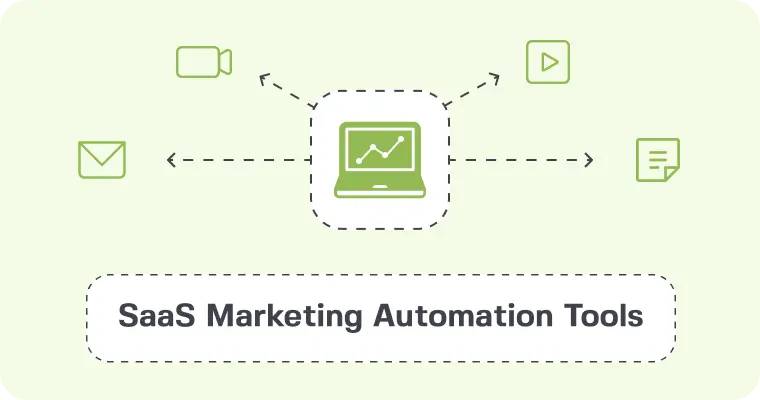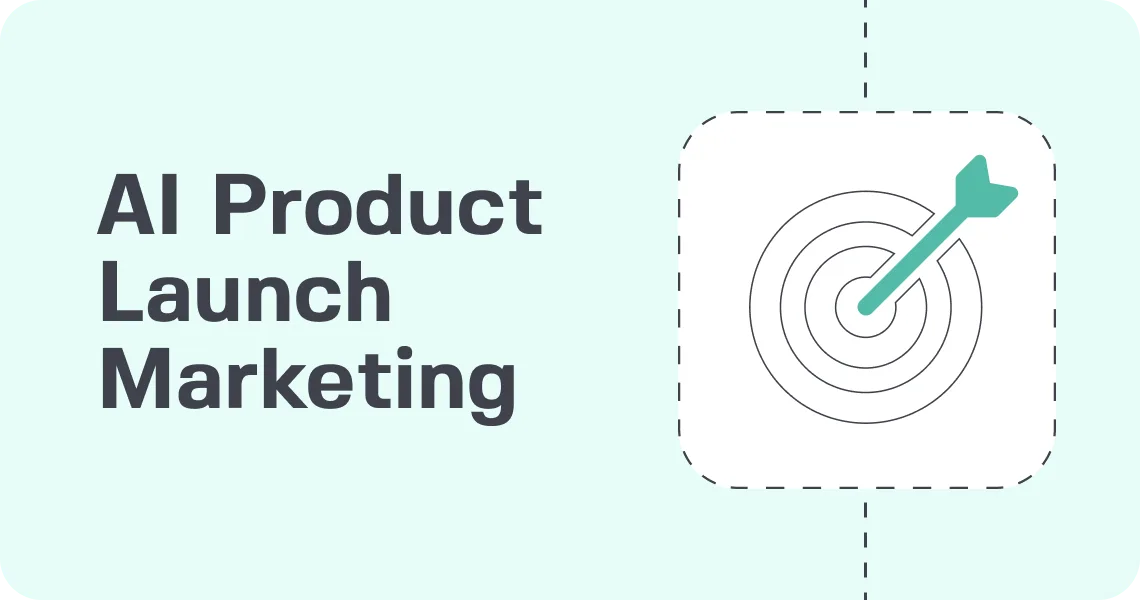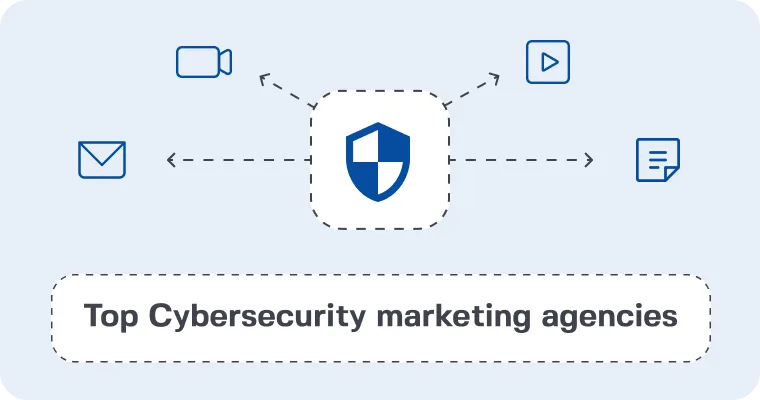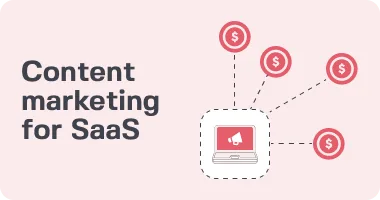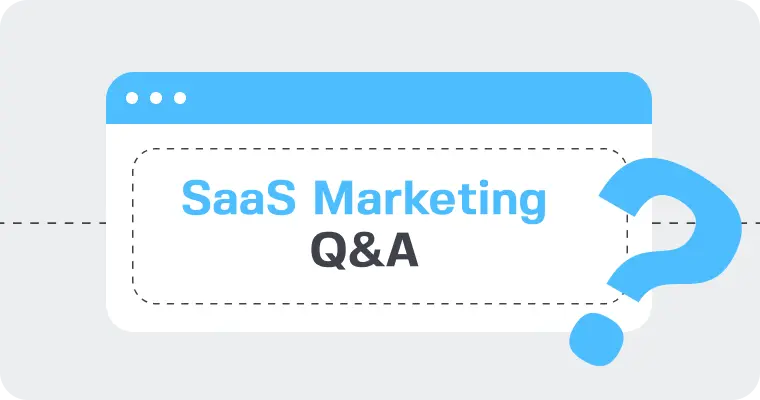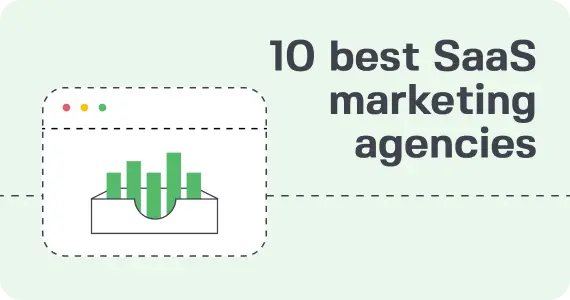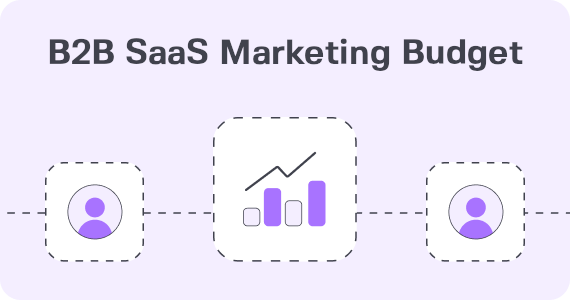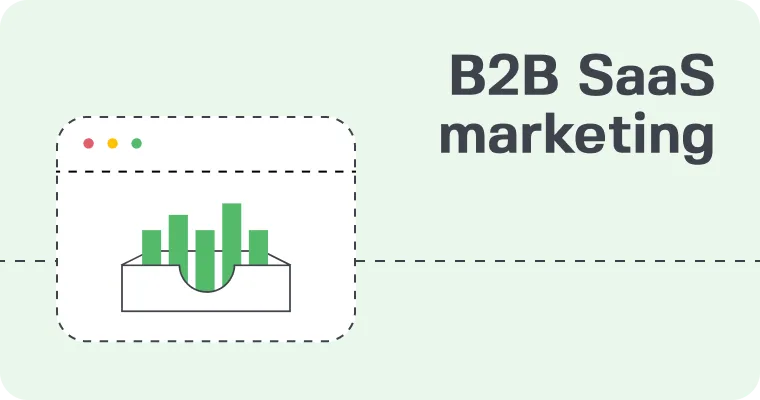B2B SaaS marketing benchmarks help give you the right reference points. Marketers rely on these stats to ensure their growth, engagement, and budgets are headed in the right direction. Getting a handle on these benchmarks is the first step toward making more intelligent, data-driven decisions. For the most current and comprehensive industry data, having an annual SaaS benchmarks report is highly recommended.
Why 2026 SaaS Benchmarks Matter More
Benchmarks in B2B SaaS aren’t arbitrary figures—they’re the heartbeat of your competitive performance. With AI quickly rewriting the game, the definition of what “good” even looks like is changing in a blink. Companies using AI today are pulling ahead, setting 2026’s benchmarks that might be double or triple what we saw just two years ago. These benchmarks are often grounded in industry standards established by leading SaaS firms, with public SaaS companies providing key benchmark data and setting trends that shape expectations for the entire sector.
Knowing what’s current and what’s coming up is the difference between leading the pack and playing catch-up.
Why do we need to track B2B SaaS KPIs?
KPIs such as monthly recurring revenue, churn rates, and trial-to-paid conversion rates fuel nearly every boardroom discussion. That’s not where the real magic happens. The real magic comes when you are comparing your numbers to what’s normal.
Some of the best companies are already achieving 15-20% organic traffic growth quarter-over-quarter and are leading the charge to scale. Benchmarks related to onboarding are more than vanity stats. Those who feel they are getting value within the first 90 days tend to have higher retention rates.
To make benchmarks even more actionable, teams can filter benchmarks by criteria such as company size, product category, or pricing model to gain more relevant insights.
This results in reduced churn and increased revenue predictability. Benchmarks help to move beyond gut feelings. They help you know where to double down on your resources—be it improving onboarding flows or going all in on SEO.
The Stakes: Your Growth Compass
Growth goals that are stretch yet achievable. That’s the power of benchmarks. They enable teams to develop targets based in reality, not just wishful thinking, using growth rate as a key metric for setting and evaluating these goals. Benchmarks also help teams understand what is achievable by comparing growth rates with industry peers.
Beyond Numbers: Strategic Insights
Benchmarks aren’t just yardsticks—they’re springboards for strategy. Seeing trends, like the flat line of inflation-adjusted infrastructure spending or changing innovations in AI, allows you to be the first mover. Detailed insights from benchmarking can inform strategic decisions, helping you identify opportunities and areas for improvement.
Agile teams that learn quickly, win quicker. They create a culture of continuous improvement, not just meeting the goals, but exceeding them. By analyzing trends and data, teams gain valuable insight that drives ongoing optimization and success.
Core SaaS Health & Growth Metrics
We believe healthy SaaS businesses are founded on objective data, not instinct. In the B2B SaaS world, there are only a few key metrics that indicate the overall health of a company. These are often referred to as key saas metrics, which are essential for evaluating company health.
Second, they’re pretty amazing at monitoring their own smart growth. These performance metrics allow teams to identify trends, react more quickly, and make more informed decisions about where to invest time and money.
Let’s take a look at the most important metrics—consider these your dashboard gauges, not just the board deck numbers.
Annual Recurring Revenue (ARR) Growth
ARR is the beating heart of SaaS health. It illustrates the level of recurring revenue your company generates yearly, leveling out any seasonal variances and non-recurring contracts. The structure of your annual contracts directly impacts ARR calculations, as these contracts define the predictable revenue stream recognized each year.
Healthy, forking ARR growth indicates you’re developing a long-term, stable base and not merely erratically chasing one-off successes. Having specific ARR targets aligns your sales and marketing departments towards the same objective.
For example, a SaaS firm targeting $5M ARR can rally its team around that number, using annual contract value as a key metric for setting and tracking ARR targets, and monitoring progress month by month.
Digging into the drivers—be it pricing changes or a retention initiative that you just launched—allows you to course-correct quickly and keep your revenue engine running smoothly.
Customer Lifetime Value (LTV) to CAC Ratio
This ratio is one of the clearest signals as to whether your strategy to acquire new customers is sustainable over time. A healthy LTV to CAC ratio for B2B SaaS usually lands between 3:1 and 5:1. When calculating CAC, it’s important to include all marketing costs, such as advertising, wages, agency fees, and overheads, as these significantly impact the true cost of acquiring a customer.
Knowing what this number is tracking can easily identify places to tighten the spending or double down on what’s working. Additionally, your business model will influence both your LTV to CAC ratio and the strategies you use for customer acquisition.
Net Revenue Retention & Churn Rates
Retention is the unsung hero of SaaS growth. Net revenue retention (NRR), also known as net dollar retention, tells you what percentage of recurring revenue you’re holding onto from your current customers.
It takes into consideration losses as a result of churn and gains from upsells. A growing NRR indicates customers are sticking around—and even increasing their spend—while a high churn is a red flag for issues with your product or experience.
Most U.S. SaaS businesses track monthly churn, with a good goal there being under 2% per month. Using churn benchmarks helps you evaluate your performance against industry standards. Spotting customer churn spikes early allows you to address issues before the revenue has eroded.
CAC Payback Period: Efficiency Check
CAC payback period is the metric that tells you how many months it takes to recoup what you invested in acquiring a customer. The shorter, the better—it improves cash flow, enhances revenue growth efficiency, and allows you to reinvest in growth.
SaaS teams often use this metric to make the case for budget increases or trims, keeping spending in line with returns. Optimizing CAC payback also directly contributes to overall profitability, making it a key financial metric for sustainable growth.
Key 2026 B2B SaaS Marketing Funnel Goals
Your B2B SaaS marketing funnel shouldn’t be a leaky pipeline. It’s a vibrant, breathing ecosystem that dynamically shapes each touchpoint and step along the way, from that initial click to an executed contract. For 2026, benchmarks become more pointy and sophisticated. The structure and strategy of your funnel should be influenced by your go-to-market motion, as different motions require tailored approaches to each stage.
- Website Engagement & Traffic Quality
Metrics such as time on page, bounce rate, and scroll depth should be analyzed to develop a clear picture of what content attracts the most user interest. When users don’t find the content they’re looking for quickly and easily, or the content feels clunky, conversion rates take a hit.
Marketing teams rely on Google Analytics and other tools to identify these trends. They may find out that users churn before getting to the pricing table, or that mobile traffic converts 50% lower than desktop. It’s important to note that engagement benchmarks can vary significantly by product category, so B2B SaaS leaders should segment their data accordingly to make informed decisions.
Small tweaks in UX or content, like adding explainer videos or streamlining forms, lift engagement and nudge quality traffic toward lead capture. - Lead & MQL Generation Velocity
Establish a goal of a certain number of leads and MQLs per week or month. If the goal is 60 deals by year’s end, backtrack the math: how many MQLs do you need, knowing only 5% of site visitors become leads and 50% of leads become MQLs?
Lead velocity is production speed—tracking the pace at which new leads move through the B2B marketing funnel lets you time impactful campaigns and shift staff resources accordingly.
Additionally, nurturing leads not only increases conversions but can also drive expansion revenue through upselling and cross-selling to existing customers. - SQL & Sales Opportunity Conversion
Track how many MQLs become SQLs, then to opportunity, and finally to closed-won. Close alignment between sales and marketing is critical.
Consistent pipeline reviews flush out opportunities for logjams. Additionally, focusing on existing customers for upselling, cross-selling, and retention can drive more reliable growth and improve net revenue retention. - Optimizing Customer Acquisition Cost (CAC)
CAC benchmarks are an invaluable tool to keep teams honest about spend. Drill into costs by channel: are events, organic search, or paid ads most efficient? Additionally, your pricing model can significantly influence CAC and conversion rates, as a well-structured pricing model can make your offering more attractive and improve acquisition efficiency.
Having hard CAC targets in place helps ensure sustainable growth in the long run. Smart spend accelerates ARR without emptying the coffers. - Overall Funnel Performance & Win Rates
Alongside conversion rates, tracking average revenue per deal is a key metric for evaluating funnel performance. Funnel reviews—monthly or quarterly—should identify what’s working and where prospects are getting hung up. If you’re seeing a high rate of “no decision” losses, it might be time to rethink your messaging or demo approach.
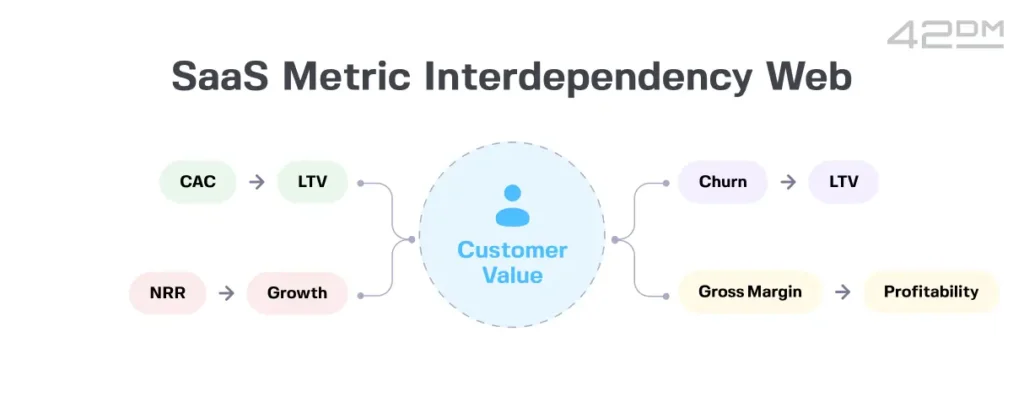
How AI Has Changed Marketing Metrics
The B2B SaaS landscape is not what it used to be just a few years ago. AI is more than a buzzword. Today, AI is the driving force behind a revolution in our understanding and measurement of marketing success.
With AI-generated content drastically reducing time spent writing while maintaining quality levels, the speed and detail level of measurement has completely flipped on its head. There’s increased pressure to measure what truly makes an impact, whether that’s personalized engagement or the speed at which campaigns react to incoming data. AI also enables the integration of new data, allowing marketers to capture and analyze fresh, real-time information for more accurate benchmarking.
This means marketers need to rethink their old habits. First, they should familiarize themselves with new benchmarks and benchmarking data, particularly as AI tools become more advanced.
Traditional Metrics Under AI’s Lens
In the past, marketers played it safe by defaulting to legacy metrics such as click-through rates, impressions, and form fills. These traditional metrics, often referred to as SaaS metrics, form the foundation for performance measurement and benchmarking in the industry. Even in an AI-centric world, these fundamentals still apply.
With the help of AI’s unprecedented capacity to sift through massive data sets, these measures are shown to fall short. As an illustration, detailed customer journey stages can get lost in traditional reporting.
AI can now identify at what stage prospects fall away or convert, exposing flaws in outdated models. Reimagining involves interlacing AI-powered insights.
These actionable insights, such as engagement scores and predictive lead scoring, allow teams to go beyond simply measuring activity to truly understand behavior at an individual level.
New AI-Driven KPIs to Watch
AI introduces new KPIs that speak to today’s demands. Imagine more accurate dynamic customer lifetime value, churn prediction accuracy, and real-time cost per acquisition.
AI-integrated tools can analyze user behavior to identify potential churn, enabling marketers to create more effective retention campaigns or offer timely incentives to stay.
Tracking customer response to AI-personalized content further provides a more accurate picture of what works and what doesn’t. These insights empower more precise targeting and more agile campaigns, a necessity in the cut-throat world of SaaS markets. Proprietary research can further enhance these AI-driven KPIs and insights by leveraging exclusive data and unique industry benchmarks.
Measuring AI Tool Impact Effectively
It’s not enough to simply roll out AI; marketers must be able to demonstrate its worth. Frameworks today measure the change that AI tools cause to bottom-line metrics—such as sales cycles being shorter, lead quality being higher, or improved financial outcomes.
Feedback loops, where human judgment and data work in tandem, allow for continuous model refinement and long-term ROI measurement. As AI continues to adapt, regular evaluation and an openness to render set benchmarks will ensure that strategies remain realistic and effective.
Channel Performance: 2026 Expectations
Marketing teams will need to manage more channels. They need to be prepared to give the proverbial eagle eye to performance and remain nimble as market forces change.
The new normal will be a unified dashboard across Revenue, Growth, Acquisition and Retention that gives you a real-time pulse on each channel. Channel performance trends are also shaped by broader shifts within the SaaS industry, making it important to stay updated on industry-wide changes.
Organic Search & Content ROI
SEO is still considered a tried-and-true channel, but long-term strategies can take four months to a year to bear fruit. Marketers will track ROI through organic lead and revenue tracking from analytics tools such as Google Analytics and Search Console.
The top SaaS teams see high website visitor-to-lead conversion rates, thanks to sharp content calendars and constant keyword optimization. Think: regular updates, deep-dive guides, and content mapped to every stage of the funnel.
Paid Ad CPA & Click-Throughs
Display and search ads too are getting cheaper and more targeted. Cost per acquisition & click-throughs campaigns measure CPA and click-throughs to ensure ad spend is sustainable. Analyzing performance data from the first quarter can help identify trends and optimize campaigns for better results.
According to ahrefs research, Google’s AI overview decreases CTR up to 34.5%. Success in this realm requires laser-focused targeting, creative A/B testing, and budget shifts on a dime.
Email Marketing Engagement Targets
Email is still an incredible value channel, with targeted and segment specific emails frequently outpacing one-off blasts at driving engagement.
A/B tests—subject lines, CTAs, send times—provide incremental improvements. Additionally, well-crafted email campaigns can play a key role in supporting customer success initiatives by improving customer engagement and retention.
Social Media & ABM Effectiveness
Social media and ABM campaigns establish engagement and conversion objectives from the beginning. These campaigns are specifically designed to drive growth by increasing conversions and nurturing leads. In-depth audience analysis fuels content strategy adjustments that increase conversions and strengthen lead nurturing efforts, particularly on LinkedIn and X.
Emerging Channel Potential in SaaS
Whether it’s new channels—from podcasts to new media platforms—each new channel is piloted with known, clear benchmarks. Understanding how to influence the current channel is imperative.
Failing to optimize these new channels can result in lost revenue opportunities, impacting overall business growth and profitability.
They test the outcome of a pilot, then go all in or turn on a dime.
Smart SaaS Marketing Spend in 2026
Smart planning your 2026 SaaS marketing budget involves a focus on efficiency and flexibility. Companies are making every dollar count, finding balance between growth ambitions and changing market realities. Marketing spend is often calculated as a percentage of total revenue, helping teams align budgets with business performance.
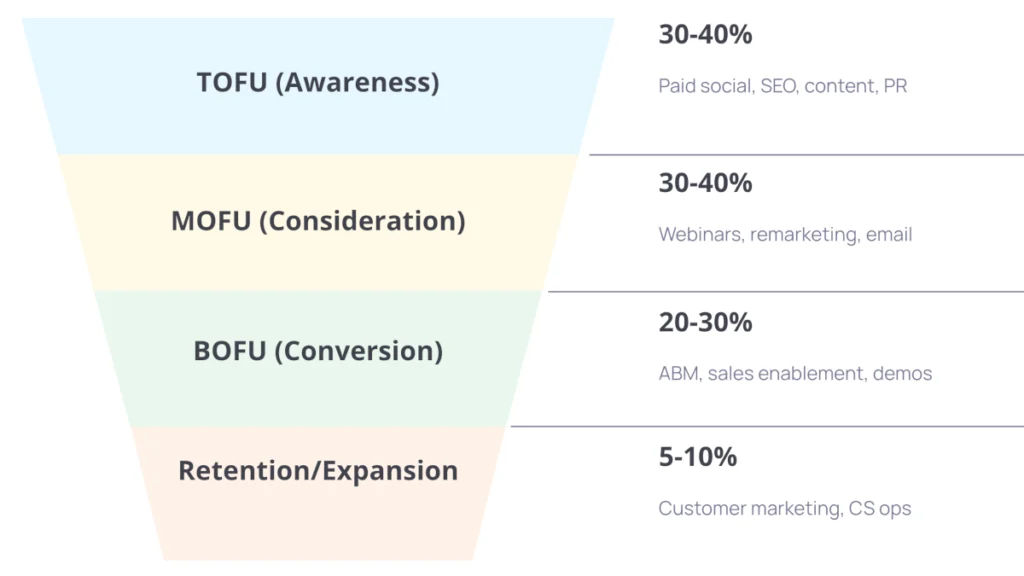
When setting targets, it’s also helpful to check annual SaaS benchmarks to ensure your spend aligns with industry standards.
- Funding Stage Impact on Budgets: Whether you’re at the idea, MVP, or growth stage, it pays to track how peers at similar stages invest, so you don’t under- or overshoot. Comparing current spending patterns to the previous year can help identify trends and shifts in budget allocation. When resources are scarce, strategies are inventive. A pre-seed team may play more to scrappy tactics, whereas a Series B company is making big investments in multi-channel campaigns.
- Departmental Spending Breakdowns: Breaking out spend by department reveals where the money is working the hardest. Spending breakdowns can vary significantly depending on the type of saas business, as different SaaS business models may prioritize certain departments or strategies over others. Teams start to harmonize spend with overarching objectives—demand generation, product marketing, and operations each receive a cut. Consistent monthly or quarterly reviews will identify any drift before it gets too far off course, ensuring that dollars continue to power results.
- Prioritizing Efficient Growth Investments: The smart bets are those that are based on what actually drives meaningful outcomes. Smart leaders prioritize by ROI, and then monitor campaign results to determine the best paths forward. Investment outcomes are compared to identify which strategies deliver the highest impact and to refine future decisions. This method incentivizes agility and learning as opposed to the default of continuing with last year’s plan.
- Aligning Spend with Company Size: Benchmarking peer performance helps to keep budgets realistic and strategies competitive. Partnerships with organizations can provide valuable benchmarking data for spend alignment.
Conclusion
Looking further down the road, B2B SaaS marketing is no longer pursuing vanity metrics—it’s creating a genuine feeling of advancement. Benchmarks help teams around the world know they have a strong starting point. The true magic happens when they go through those figures with new perspective. AI is very much in the process of changing what’s working and what’s not, completely reshuffling the deck on channels and spend. Growth isn’t simply doing more of what worked last year. It’s not just about being agile—it’s about being adaptive—testing, learning, and continually tuning strategy as technology and buyer behavior change. 42DM B2B SaaS marketing agency treats benchmarks like mile markers, not finish lines. Metrics are a guiding principle. It’s that trifecta of no-bullshit measurement, beautiful creativity, and a healthy dash of hard work that propels SaaS marketing.


